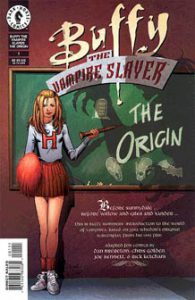Dark Horse’s “Buffy” comics have been canonical for the past decade, but the first story that is officially part of the canon came out much earlier: “The Origin” (January-March 1999) takes Joss Whedon’s script for the 1992 movie, translates it into a three-issue comic series and gives it the necessary tweaks to fit with the universe and timeline of the TV show.
Whedon was in a difficult position with the movie: He wanted to distance himself from it, because he didn’t like the comedic direction and some of the performances (particularly Donald Sutherland’s). On the other hand – aside from specifics such as Buffy’s year in school and what happens to vampires when they are staked – the movie is the backstory to the TV series.
In Buffy’s first meeting with Principal Flutie in “Welcome to the Hellmouth” (Season 1, episode 1), he is concerned that she burned down the gym of her Los Angeles school (something that doesn’t happen in the movie, but does in “The Origin”). In “Becoming, Part 1” (2.21), we see a remake of the scene of a candy-sucking Buffy being discovered by Merrick, her first Watcher – of course with Sarah Michelle Gellar as Buffy and Richard Riehle as Merrick, replacing Kristy Swanson and Sutherland.
Although adapted by novel writer Christopher Golden and Dan Brereton rather than Whedon himself, “Buffy’s” inventor mostly praised “The Origin”: “The origin comic, though I have issues with it, CAN pretty much be accepted as canonical. They did a cool job of combining the movie script (the SCRIPT) with the series; that was nice, and using the series Merrick and not a certain OTHER thespian who shall remain hated.”
Part of why Whedon didn’t flat-out reshoot Buffy’s origin story (perhaps as a flashback episode) is because he chose to revisit the ideas in Season 1. For example, Buffy has dreams of past Slayers at the start of both stories. Pike has to kill his best-friend-turned-vampire, Benny, just as Xander has to dispatch Jesse in “Welcome to the Hellmouth.” The Big Bad, Lothos (who is often called “The Master”), is trapped beneath the school, waiting for his minions to garner enough power to raise him – and when he does rise, the scene looks the same as The Master’s rise in “Prophecy Girl” (1.12).
Lothos and The Master see Buffy the same way: As the latest incarnation of the Slayer, whom they will kill yet again. At the end of both arcs, Buffy wins not because she’s a Slayer, but because she’s Buffy – someone with ingenuity and friend(s). Merrick suggests that Buffy should feel like she is part of a lineage (“Did you ever dream that you were someone else?”), and certainly her dreams are powerful. But as the saga goes forward, Buffy’s dreams of past Slayers diminish, and she embraces her individuality.
In both “The Origin” and Season 1, Buffy is torn between her calling and her desire for a real life, particularly getting ticked off about her Slayer duties in the final act. (Interestingly, Buffy’s “Origin” dress for the climactic dance is blue, whereas she wears a white dress – and later a leather jacket over it — in the movie, resembling her choice in “Prophecy Girl.”) While Whedon was obviously revisiting thematic points for the sake of the new TV audience, it’s not at all odd that Buffy would work through these issues a second time, since life isn’t a series of precise steps to be completed.

In terms of specific scenes, though, Golden and Brereton try to avoid copies. A scene in Whedon’s script – as reflected by Richie Tankersley Cusick’s August 1992 novelization – finds Buffy tricking a vampire in the final battle by threatening to open a window to the sunrise, when it’s actually four hours too early. She does the same thing in “Welcome to the Hellmouth,” which is no doubt why Golden and Brereton discard it from “The Origin.”
Other discards streamline “The Origin” while also matching up with Season 1’s new rules. The comic excises references to a birthmark on a Slayer’s shoulder, and cramps tipping a Slayer off to the presence of vampires.
It seems Whedon was still working out the breadth of the role of Watchers when he wrote the movie script. “The Origin” adjusts a scene from page 90 of Tankersley Cusick’s novelization. In the book, we learn that Merrick grew up in England, where “My father taught me about the training, about finding the Slayers, reading the signs. There’s a small cluster of us, a few families, really. Most of the neighboring villagers think we’re just a bunch of harmless old loonies.” In Issue 2 of the comic, the writers allow for the existence of a bigger Watchers’ Council. Merrick says: “My father taught me everything about the training, and the legends, and research, and a lot of subtleties the Council never bothered with.”
“The Origin,” like the novelization, includes Merrick’s mention that he “trained” five girls “to be Slayers.” The phrasing allows for the notion that he trained five Potentials, which is more likely than one Watcher being assigned to five Slayers. However, he notes that they were “all ripped apart,” which fits with the idea that they were Slayers rather than mere Potentials – who would be unlikely to get into real fights against vampires or demons. (Since Merrick never appears in another story as the Watcher of past Slayers, though, we have to assume they were Potentials.)
Besides Buffy, the only other character to jump from “The Origin” to the TV series is Joyce, who was simply known as Buffy’s mom in the movie. Brereton and Golden somewhat downplay Joyce and Hank’s lax parenting from Whedon’s script, but it’s clear that Buffy is raised as a latchkey kid while her folks go to important functions. In Tankersley Cusick’s novelization, Joyce asks Buffy if she has any idea what time it is. Buffy fears she’ll be in trouble for getting home late, but her mom is just concerned that her watch stopped.
“The Origin” includes the clever, against-the-grain dialogue Whedon is known for. Buffy’s friend, brainstorming environmental themes for the dance, says “What about the ozone layer?” “Right, we gotta get rid of that!” Buffy replies. Whedon further plays up the “ditzy girl” aspect of his “ditzy-girl-turned-superhero” arc by having all of Buffy’s male counterparts see her as a sexual object. Andy asks Buffy’s boyfriend, Jeffrey, “Could I just borrow her for a while?” The girls AND boys are so vacuous that Lothos assumes Buffy will be no threat simply because of the environment she comes from.
Intentional or not, Buffy’s lack of true friends – and the fact that she doesn’t totally warm up to Pike (as she’s understandably distracted by other things) — gives a sad quality to “The Origin.” But this is ultimately a good thing. It makes us happy to see Xander, Willow and Giles on the final panel, as Buffy concludes telling this story to them.
While all of Buffy’s Cordelia-esque friends are easily (and perhaps intentionally) forgotten, there is one supporting player who stands out. Pike (who is drawn somewhat like the movie’s Luke Perry, since there’s no TV version of the character) is a good-hearted gearhead who admires Buffy from afar and stays in town to help her. He’s a potential love interest and a reliable sidekick. Some reviewers have said Pike fills the damsel-in-distress role in Whedon’s gender-role-reversing script, but he holds his own enough to at least put him on par with Xander.
While Whedon was not interested in further exploring Pike, he did allow the novels and comics to use him. Pike is still by Buffy’s side in “The Origin” comic-book sequel “Viva Las Buffy!” (Issues 51-54 of the original series), and he pops up later in the timeline in the comic “Notes from the Underground” and the novel “Sins of the Father.”
From the pencils of Joe Bennett and the inks of Rick Ketcham, “The Origin” features even more stylized vampires than most “Buffy” comics, some looking much more demonic than human (as always with the comics, the vampires are green). This is an odd choice for a comic with the specific aim of mimicking the TV show’s style and character portrayals. I don’t mind it – it is a comic, after all – and some have said that since “The Origin” is Buffy’s telling of the events to Willow, Xander and Giles, that explains the embellishments.
“The Origin” includes two mistakes: A headstone in Issue 1 says a student died in 1990, rather than 1996, and Pike is given vampire-style speech bubbles in Issue 3. Otherwise, “The Origin” is a respectable debut for our favorite Slayer. Lacking so many characters we love, it doesn’t come close to overshadowing the TV show, but it gives us the foundation of Buffy’s hero’s journey.
Click here for an index of all of John’s “Buffy” and “Angel” reviews.

